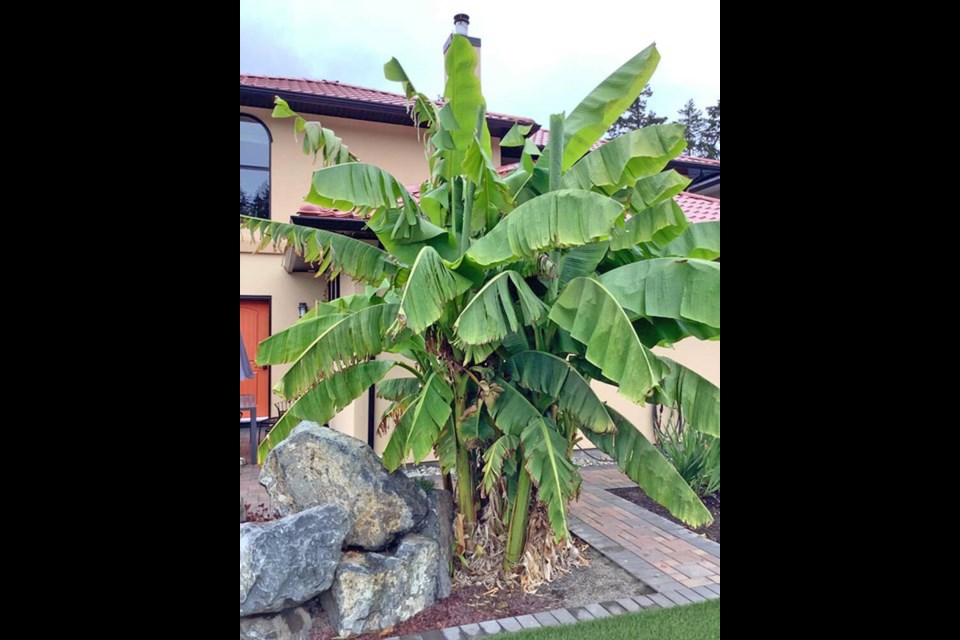Early in the fall, Linda, who gardens with her husband Glenn in Langford, sent me an email with several photos: “I wanted to show you our banana plant that has produced bananas. We planted it in the spring of 2018.
“We enjoy the tropical, sort of Mediterranean look. We never expected to see any fruit. I believe they are not the edible kind. They won’t do much now with the weather cool and wet. Having the plant in the garden has been fun for the family and the neighbours..
“My husband cuts it down after it shrinks away in the fall. It keeps coming back.”
Linda and Glenn’s banana plant is probably Musa basjoo, a species grown commercially for its fibre, which is used in textile production. It has a lush, topical look and is probably the hardiest of the bananas.
The banana is the national fruit of Uganda. The native species, matoke, provides the main, staple food in the country. Banana fibre is used to create a fabric called bark cloth, used for traditional clothing. The fibres are also used in creating works of art. Students in the school where I taught created pictures using different shades of banana fibre. I have two of them hanging in a bedroom in my home.
In these worrisome times, gardeners can dream, if not of banana palms, of lush summer plantings and productive seasons ahead, and begin planning for them. As the demand for seeds and other gardening supplies continues to surge, acquiring them as early as possible is wise.
Growing Figs in Cold Climates, by Lee Reich (New Society Publishers, 128 pages, paperback, $24.99). Though much in this new book is applicable mainly to climates colder than ours, there is much that is of interest and use as the author delves into the subtropical nature of the fig tree, its drought tolerance, fruiting habit, and innovative ways of training and nurturing the trees.
One chapter is a directory of fig varieties, with descriptions that include their suitability for different climates. For each variety there is a colour photo of a leaf or leaves.
Desert King, an outstanding fig for Vancouver Island gardeners, is known for producing a large first (“breba”) cop in summer, on young (one-year old) branches produced in the previous year.
This is good, because our season of warmth is not usually intense and long enough to mature the second (“main”) crop borne on branches produced in the current year. The second crop will usually ripen only in the very warmest, sunniest, most protected garden sites, or under high plastic tunnelling or in an unheated greenhouse.
The core of the book details five methods for growing figs in cold climates, with a prelude on preparing and maintaining nourishing soil conditions.
The first method deals with regions of severe cold, where figs need to be grown in pots that can be brought into shelter for the winter. People who garden in containers will find the thorough instructions on planting and caring for a potted fig very helpful. Even those with gardens may be attracted to the idea of having a potted fig tree, which can be ornamental as well as fruitful..
As the methods move into warmer territory, the last method, for the least cold region Reich deals with, is growing figs in a high greenhouse or hoop house, using very practical in interesting espalier and horizontal cordon styles of training for easy maintenance.
A note on pruning methods: This guide is geared mainly for cold winter regions, where young branches that would bear the next year’s first (breba) crop might not survive the severe cold. For that reason, pruning for the second, later crop on new branches is emphasized.
For an excellent demonstration, and explanation, of pruning a fig tree in North Saanich, for the early crop, type “Fruit Trees and More + fig pruning) into a search engine.
VHS meeting. The Victoria Horticultural Society is hosting a Zoom meeting on Tuesday, 7 to 8:30 p.m. The featured speaker will be Egan Davis, who is currently Manager of Parks for the City of White Rock. He previously taught and practised horticulture at UBC and VanDusen Botanical Gardens. He will talk about the principles and methods of plant propagation. Drop-in fee for non-members is $5. To register, visit vichortsociety.org.


